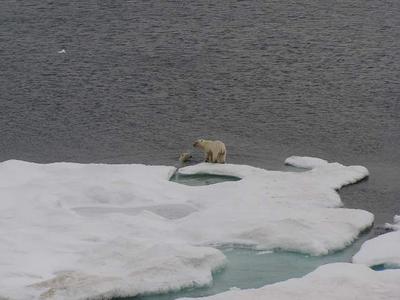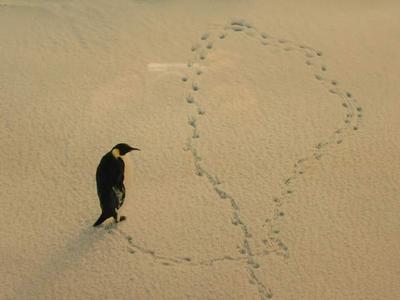27 July, 2003
"Men wanted for hazardous journey. Small wages, bitter cold, long
months of absolute darkness, constant danger, safe return doubtful.
Honor and recognition in case of success."
So went explorer Ernest Shackleton's help-wanted ad for his planned
journey across the Antarctic continent. Needless to say, an ad
seeking applicants for this cruise would be a little different. For
starters, we're experiencing 24 hours of lightness, and nearly one
third of the science team is women. And the only constant danger
comes from the continuous great galley meals and treats.
It's hard, however, not to think about Antarctica when you are
"experiencing the arctic." At first glance, they seem the same.
Indeed, both are cold and white and off the beaten path. But the
similarities end there:
1. Antarctica is a continent surrounded by water while the
Arctic is an ocean surrounded by continents;
2. Antarctic icebergs are derived largely from ice sheets
in excess of 100 cubic kilometers, whereas Arctic icebergs are
generally seasonal and measured in tens of cubic meters;
3. Sea ice around Antarctica is mostly seasonal, but up in
the Arctic, it's older, multi-year sea ice;
4. South Pole elevation is 2912 meters above sea level,
while the North Pole is about 1 meter above the sea;
5. Solid ground is only 34 meters above sea level in
Antarctica, while bedrock is about 4300 meters below the sea in the
Arctic;
6. Mean annual temperature of the South Pole is minus 50
degrees Celsius, and minus 18 degrees C at the North Pole;
7. Beaches are rare with a narrow, deep continental shelf
in Antarctica, while the Arctic has many beaches and an extensive,
shallow continental shelf;
8. Antarctica has no tundra or tree line, but in the Arctic
exists a well-developed tundra and highly-defined tree/shrub line;
9. Only lichen exists at 82 degrees south, whereas there
are over 90 species of flowering plants at 82 degrees north;
10. Two species of flowering plants are present between
66-70 degrees south, but more than 450 flowering plants north of 66
degrees;
11. Antarctic free-living arthropods include insects (2),
mites (150), and Collembolla (6), while there numerous Arctic
Arachnids, crustaceans, insects, and myriapods,
12. No terrestrial animals are found in Antarctica, but it
the Arctic, there are musk ox, reindeer, caribou, fox, hare,
lemmings, bears, and so on;
13. 14 kinds of whales and porpoises and 4 species of seals
are found in the Antarctic, but 18 whales and porpoises and 7 seals
are in the Arctic;
14. 19 species of birds can be found between 70- 80 degrees
south, while there are 107 kinds of birds from 75-80 degrees north;
15. No record of human habitation or native groups exist for
the southern continent, but indigenous peoples with a long, rich
cultural record are found up north;
16. Human population is sparse south of 60 degrees, while it
exceeds two million north of 60 degrees;
17. Little exploitation of natural resources in Antarctica,
whereas there is widespread exploitation and technological
development in the Arctic;
18. Captain James Cook (according to some) was the first to
cross the Antarctic Circle on Jan.17, 1772, but the Arctic Circle
crossing is prehistoric;
19. Permanent research station is located at the South Pole,
while only Santa Claus can be found at the North Pole; and finally,
20. Polar Bears do not eat penguins!

The Arctic midnight sun.

Not in the Antarctic says the sow to its cub standing on the ice.

Only in the Arctic can you see something like this.

A wayward penguin in the Arctic - is this possible?
Contact the TEA in the field at
.
If you cannot connect through your browser, copy the
TEA's e-mail address in the "To:" line of
your favorite e-mail package.
|
